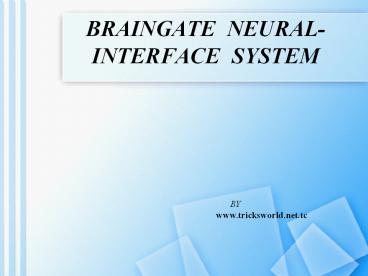BRAINGATE NEURAL- INTERFACE SYSTEM - PowerPoint PPT Presentation
Title:
BRAINGATE NEURAL- INTERFACE SYSTEM
Description:
Working The braingate neural interface device is a propriety brain-computer interface that consist of an inter neural signal sensor and external processors that ... – PowerPoint PPT presentation
Number of Views:2018
Avg rating:3.0/5.0
Title: BRAINGATE NEURAL- INTERFACE SYSTEM
1
BRAINGATE NEURAL- INTERFACE
SYSTEM
BY www.tricksworld.net.tc
2
Introduction
- BrainGate is a brain implant system developed by
the bio-tech company Cyberkinetics in 2003 in
conjunction with the Department of Neuroscience
at Brown University. - Purpose
The
system is to help those who have lost control of
their limbs, or other bodily functions, such as
patients with spinal cord injury to operate
various gadgets such as TV, computer ,lights, fan
etc..
3
Scope
- During paralysis the brain generates the signals
but these signals do not reach the intended
muscles. Hence the muscles do not react and thus
no movement is observed. A solution to this
problem can be a direct interaction between the
brain and appliance. Thus no muscle movement is
required to get the work done. The brain can
directly do it. The user must only be equipped
with this braingate system.
4
A Brief history
- The braingate is the culmination of 10 years of
research in the laboratory of Dr.John Donoghue,
who is the chair man of the Neuroscience
Department at Brown University and chief
scientific officer for cyberkinetics. He studied
the functioning of braingate in monkeys and
proved that they were able to control a curser on
a computer monitor with their thoughts. - They have not only demonstrated in preclinical
studies that braingate can remain safely
implanted in the (monkey) brain for at least two
years, but have shown that it can safely be
removed as well.
5
Working
- The braingate neural interface device is a
propriety brain-computer interface that consist
of an inter neural signal sensor and external
processors that convert neural signals into an
output signal under the users own control. The
sensor consists of a tiny chip smaller than a
baby aspirin, with one hundred electrode sensors
each thinner than a hair that detect brain cell
electrical activity.
6
(No Transcript)
7
The components in this system
- The chip A 4-millimeter
square silicon chip studded
with
100 hair-thin
microelectrodes
is embedded
in the primary
motor cortex
the region of the brain
responsible for controlling
movement - The connector When the user thinks move
cursor up and down, the cortical neurons fire in
a distinctive pattern the signal is transmitted
through the pedestal plug attached to the skull
8
- The converter The signal travels to a
shoebox-sized amplifier mounted on the users
wheelchair, where its converted to optical data
and bounced by fiber-optic cable to a computer. - The computer The computer translates brain
activity and creates the communication output
using custom decoding software.
9
HOW INFORMATION IS TRANSMITTED?
- When a work is done through any part of body then
a potential difference is created in the brain. - This potential difference is captured by the
electrodes and is transmitted via fiber optic to
the digitizer.
10
- The digitizer converts the signal into some 0s
and 1s and that is feed into the computer. - Thus a new path for propagation of brain commands
from the brain to the computer via braingate are
created. - Now when external devices are connected to the
computer ,then they work according to the thought
produced in the motor cortex.
11
(No Transcript)
12
HOW DIFFICULT IS THIS SURGERY
- Surgeon makes craniotomy thats the diameter of a
50-cent piece. - The sensor is implanted in the region that issues
command to the arms - The whole surgical procedure takes two and half
hour.
13
APPLICATION
- Turn on or off the lights
- Control robotic arm
- Watch and control television
- Use the pc
- Locking or unlocking doors
- Motorized wheelchair
14
ADVANTAGES
- Controlling remote devices
- Making and receiving telephone calls
- Accessing the internet.
15
DISADVANTAGES
- Expensive
- Risky Surgery
- Not Wireless yet
16
FUTURE SCOPE
- Current new advances include a
second-generation interface
software
MPower controller
that will enable users to
perform
a wide variety of daily activities
without
assistances of technician. - Smaller ,wireless device .
- The user will have an improved
control of respiratory
system, limb with
muscle stimulation or robotics.
17
Conclusion
- Cyberkinetics is further developing the braingate
system to potentially provide movement to people
with severe motor disabilities. - This remarkable breakthrough offers hope that
people who are paralyzed will one day be able to
independently operate artificial limbs,
wheelchairs. - Next generation products may be able to provide
an individual with the control device that allow
breathing , limb movements.
18
Thank U..
19
Queries??

